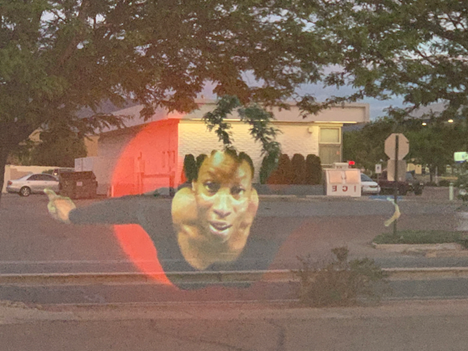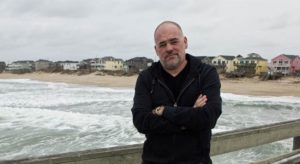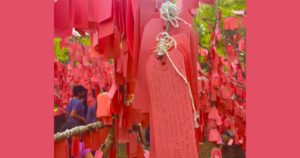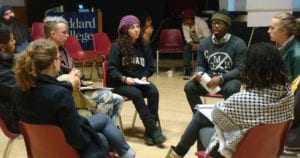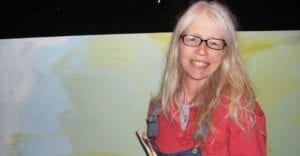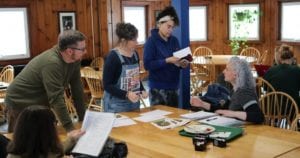
Moving back to London requires minimal adjustment, it’s as easy (as a writer once said about revision, compared to first draft composing) as sliding into a bath of warm oatmeal. No culture shock save for the first instant of wondering why dogs and babies are driving cars; all you have to do is exercise a little preliminary caution crossing the street and you’re done. Or maybe some mild culture shock, over here in the Land of Other People’s Problems, to learn exactly what the tabloid media judges important. “Horror on No. 77!” shrieks the top headline in the Evening Standard, the free newspaper everyone reads on the Tube going home after work. The word “horror” in a headline makes an American tremble, but here a double-decker bus, it seems, had crashed into a shop’s front window, causing minor injuries.
I am nicely set up in a quiet part of Camden Town, once a notorious music and clubbing scene back in the seventies and eighties and now a pilgrimage destination, much like the Haight in San Francisco, for young people wearing their grandfathers’ Mohawks. From Camden Town it is only a short walk to my research destination, the British Library. On the second walk I took there, I passed a peculiar antique building labeled St PancrasCoroners’ Court that did still appear to be in the business of accepting bodies in the slightly more modern Public Mortuary building next to it. I had just heard a BBC broadcast marking the fiftieth anniversary of the murder (by hammer blows to the head) of the playwright Joe Orton by his roommate and lover the writer and artist Kenneth Halliwell. Orton’s battered body and his lover’s suicided-by-drugs body had been brought to this very Coroners’ Court. Halliwell killed Orton, it is presumed, out of jealousy for the fact that Orton had shot to fame while Halliwell remained obscure and unknown.
The BBC program played some voice clips of Orton and those who knew him. His sister Leonie had commented that Joe fled the family and his harridan mother early on, and she believed his rare return visits home were mainly for the purpose of collecting material for his plays. Orton’s own voice, to my untrained American ear, sounded considerably more upper class than that of his sister. This, I supposed, was part of the persona construction that artists wanting to be famous often engage in, especially in class-conscious England. Did Halliwell change his accent too, I wondered? It also works the other way, of course, especially in the United States, as witness the homespun accents of both the Harvard-educated folksinger Pete Singer and the middle-class Midwesterner Robert Zimmerman who reinvented himself as Bob Dylan.
Climbing the steps past the Coroners Court, I enter a small park full of very tall trees called St. Pancras Gardens. In the corner sits St. Pancras Old Church, a very old church indeed, and this park was once its graveyard. Among the scattering of gravesites and stone markers, a diagram indicates the location of the stone sarcophagi marking the original graves of William Godwin and Mary Wollstonecraft (their actual remains were moved elsewhere by their daughter Mary).
Godwin and Wollstonecraft were both philosophers of note in their day, he for his political theorizing and she for the seminal feminist manifesto A Vindication of the Rights of Women published in 1792. Today Wollstonecraft is better known than her then-famous husband, and both are best known not for their own accomplishments but for being the parents of Mary Shelley, the author of Frankenstein. Mary Shelley in turn, whom Wollstonecraft had died giving birth to, is now better known than her own husband, the hugely influential Romantic poet Percy Shelley, who died absurdly young, drowned while sailing in Italy, and who as a nineteen-year-old married man met the sixteen-year-old Mary here at her mother’s grave in the St Pancras churchyard to plot their elopement.
I think (but am not sure) I’ve identified correctly the two weathered stone sarcophagi. In all honesty, they don’t do a thing for me. Nor does the Coroners Court (though architecturally it has a weird Dickensian charm) provide a sense of connection to Joe Orton and Kenneth Halliwell. All parties are so long gone, Orton and Halliwell less recently long gone but long gone nonetheless.
I’m thinking about fame, the getting of it and the losing of it and the never having of it. And, just as quickly, the absolute meaninglessness of it. We tend to believe that reversals of reputation in public opinion bring some kind of poetic justice in the Coroners Court of Time—that in the end, finally, a writer or artist condemned to obscurity in their own time is vindicated in posterity, the perennial example being Vincent van Gogh. But public opinion is only public opinion. It is not now or ever necessarily a bringer of truth or justice.
I am full of unhappy thoughts leaving St. Pancras Gardens, this dank little piece of land full of ancient bones abutting the public mortuary. Arriving at the British Library a few minutes later, I remember the reception the Library will host this November celebrating their purchase of the papers of the writer Robert Aickman, one of whose collections of “strange stories” I’ve just finished editing for the New York Review Books series.
A book I came across by chance in my Camden Town flat is a biography of a former lover of Aickman’s, the novelist Elizabeth Jane Howard. She died last year in her nineties and all her obituaries headlined her status not as a distinguished writer but as the former wife of Kingsley Amis, currently (but not for long) a better-known writer than she was. Besides her three marriages, Howard had a number of affairs over her lifetime and was forthright about them in her memoir Slipstream. Her biographer, Artemis Cooper, creates an emotional throughline of neediness and neuroticism for her subject. Cooper did not establish a similar throughline for the many-times-adulterous Kingsley Amis nor for the subject of her biography of the travel writer Patrick Leigh Fermor, whose sexual liaisons had to have numbered in the hundreds, if not thousands. Here a life reputation, not just a literary one, has been skewed.
By Elizabeth Jane Howard’s account and those of others, Robert Aickman was a difficult character, the kind of person we now call a control freak. But he and Howard encouraged each other’s writing and even produced a volume of ghost stories together, We Are the Dark. Aickman was cofounder of the Inland Waterways Association, which preserved and restored England’s canal system; Howard for a time was the organization’s secretary and Ray, his long-suffering wife, the vice president. The canals don’t figure very much in Aickman’s fiction, but Howard used this experience to write one of the finest ghost stories in the English language, “Three Miles Up.” Read it if you can get your hands on it; nobody seems to know much about it.
Thinking of Aickman’s stories and “Three Miles Up” cheers me up considerably as I take my seat in the Rare Book Reading Room. Out comes the laptop, the notebook, and the pencil (no pens allowed in British Library reading rooms). As I open the Londoner John Bunyan’s seventeenth-century spiritual allegory The Pilgrim’s Progress, I think of all the great departed writers of this city, the ones we remember and the ones we don’t. Long gone, every one of them—so very long gone. Hats off, glasses lifted to all these thousands and thousands of writers, their lives, their private tragedies and joys, their work!

